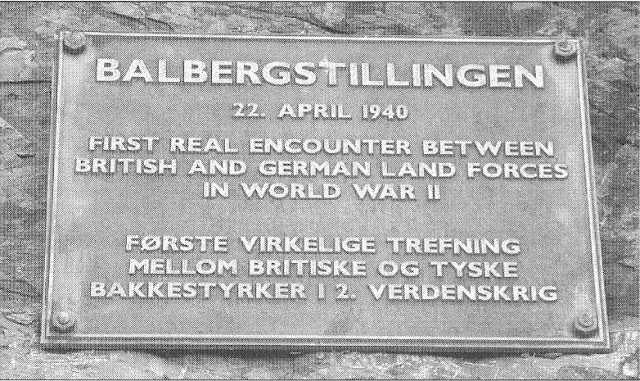Monday 22 April 1940
Norway Army Operations: The German 196th Division advancing north from Oslo captures Lillehammer and advances further up the Gudbrandsdal. The British 148th Brigade sent down to block them is forced to retreat again. They try to dig in at Faaberg, North of Lillehammer, but the German mountain troops prove that training is important when they scale the 2,165-foot Balbergkamp to sidestep the British down on the road. The British, outflanked, then retreat another 20 miles and set up a blocking position at Tretten Gorge, a narrow chokepoint in the Gudbrandsdal defile.
The 196th Division is advancing on Trondheim from the south, while the German 359th Infantry Division pushes south from Trondheim to meet them.
The German 181st Infantry Division and 3rd Mountain Division troops at Steinkjer are putting pressure on General de Wiart's 146th Territorial Brigade. There is fierce fighting at Vist between The Lincolnshire Regiment and King's Own Yorkshire Light Infantry Regiment, defending at Krogs farm, and the German 138th Mountain Regiment. In the evening, the British begin a fighting withdrawal back to the main base at Namsos. The Luftwaffe is completely crushing his base at Namsos and the British supply lines to de Wiart's troops to the south.
The German 69th Infantry troops at Bergen begin pushing east.
Norway Naval Operations: Aircraft carrier HMS Glorious departs from Scapa Flow ferrying 18 Gloster Gladiators of No. 263 Squadron for use in Norway. The Gladiators are not converted for carrier takeoffs and landings.
Norway Air Operations: The Luftwaffe bombs the British base at Namsos again. The RAF also is in operation over Norway, but they are bombers from England.
European Air Operations: The Luftwaffe bombs Scapa Flow and lays mines along the British coast.
French reconnaissance aircraft fly over Prague on 22-23 April.
Battle of the Atlantic: Two Lockheed Hudsons spot U-43 on the surface in the North Sea and drop bombs. The U-boat receives a few nicks and carries on.
Convoy OA 134 departs from Southend, Convoy OG 27F forms at Gibraltar, and Convoy HX 37 departs from Halifax.
British corvette HMS Clarkia (Lt. Commander Frederick J. G. Jones) is commissioned.
North Africa: The newly arrived New Zealand Division conducts training exercises near El Saff.
Denmark: The Germans order the Danish army disbanded and confiscate its weapons.
British Military: Three vice chiefs of staff are appointed: John Dill as Vice Chief of the General Staff; Tom Phillips, Vice Chief of the Naval Staff; and Vice-Chief of the Air Staff Sir Richard Edmund Charles Peirse. Air Marshal William Sholto Douglas is named Deputy Chief of the Air Staff, and General Percival becomes Assistant Chief of the Imperial General Staff at the War Office.
US Navy: Rear Admiral Joseph Taussig, commandant of the Fifth Naval District at Norfolk, Virginia, testifies before a joint House-Senate committee on Pacific fortifications. He predicts that war with Japan is inevitable. The US Navy officially reprimands him and repudiates his testimony.
Holocaust: Germans and Poles are forbidden from entering the Jewish Ghetto of Lodz.
 |
| Lodz Ghetto "No Entry" posting: "In accordance with the police ordinance of April 8, 1940, all Poles and Germans are forbidden from entering the Ghetto Area" (Schmitt, Federal Archive). |
April 1940
April 1, 1940: Weserubung is a GoApril 2, 1940: British Subs On Alert
April 3, 1940: Churchill Consolidates Power
April 4, 1940: Missed the Bus
April 5, 1940: Mig-1 First Flight
April 6, 1940: Troops Sailing to Norway
April 7, 1940: Fleets At Sea
April 8, 1940: HMS Glowworm and Admiral Hipper
April 9, 1940: Invasion of Norway
April 10, 1940: First Battle of Narvik
April 11, 1940: Britain Takes the Faroes
April 12, 1940: Germans Consolidate in Norway
April 13, 1940: 2d Battle of Narvik
April 14, 1940: Battle of Dombås
April 15, 1940: British in Norway
April 16, 1940: Germans Cut Norway in Half
April 17, 1940: Trondheim the Target
April 18, 1940: Norway Declares War
April 19, 1940: Dombås Battle Ends
April 20, 1940: Germans Advancing in Norway
April 21, 1940: First US Military Casualty
April 22, 1940: First British Military Contact with Germans
April 23, 1940: British Retreating in Norway
April 24, 1940: British Bombard Narvik
April 25, 1940: Norwegian Air Battles
April 26, 1940: Norwegian Gold
April 27, 1940: Allies to Evacuate Norway
April 28, 1940: Prepared Piano
April 29, 1940: British at Bodo
April 30, 1940: Clacton-on-Sea Heinkel
2019

No comments:
Post a Comment